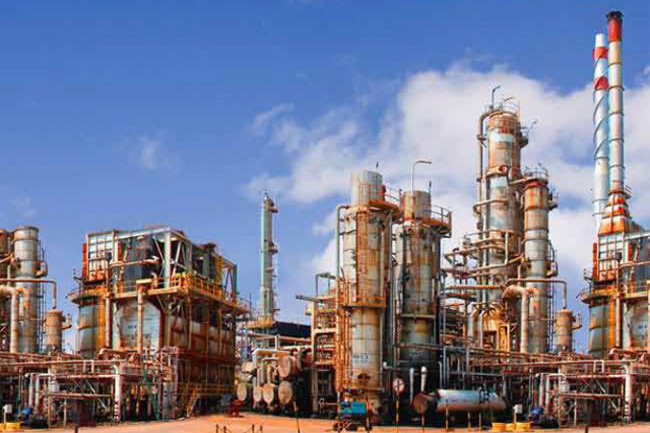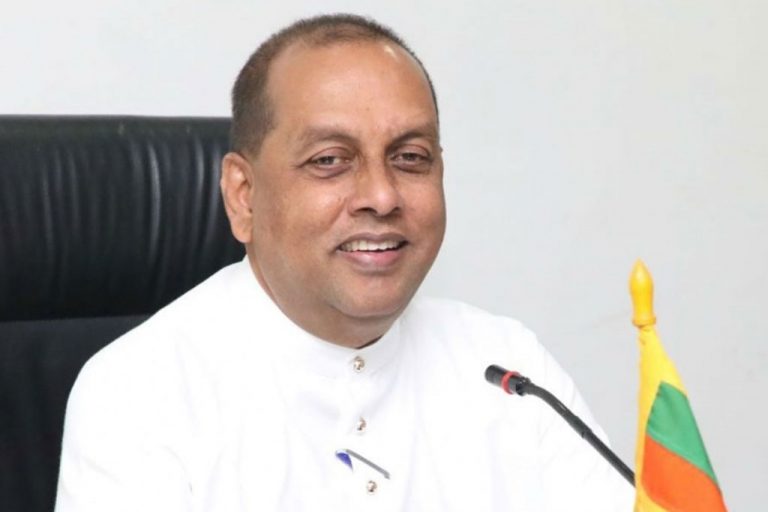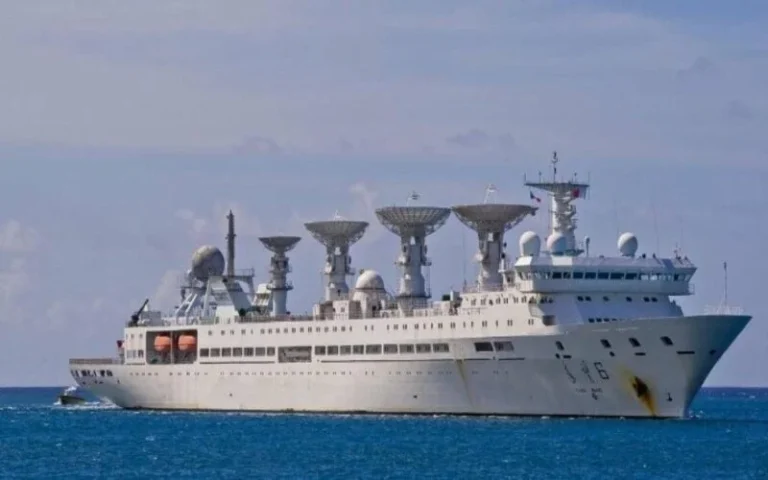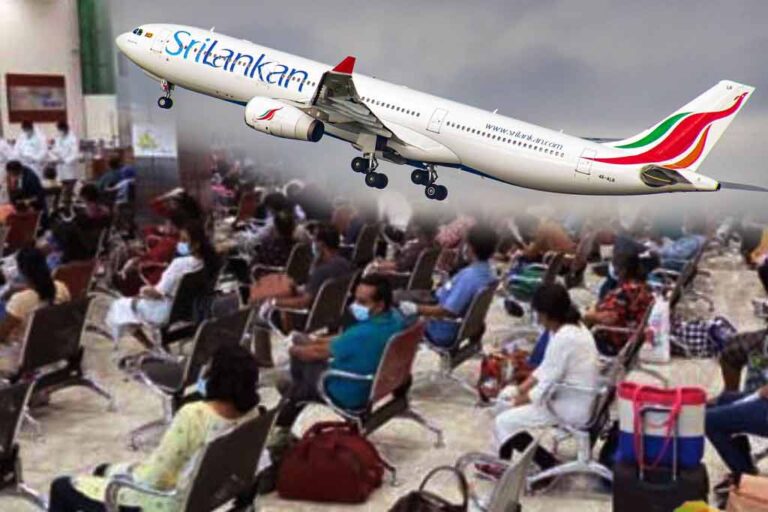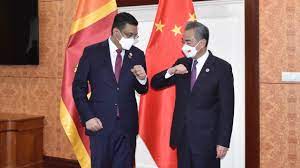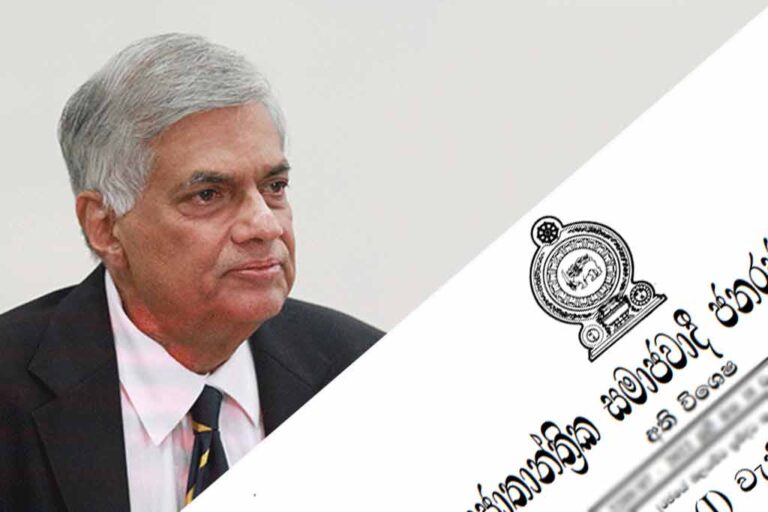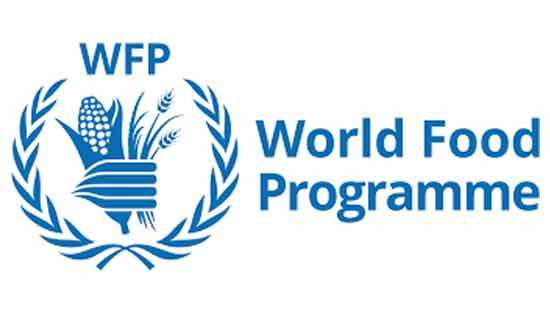Sri Lanka has overlooked fuel security with the closure of the Sapugaskanda oil refinery for at least 120 days in 2021/22 due to the suspension of crude oil imports triggering an energy crisis that has led to island-wide rolling power cuts, several Ceylon Petroleum Corporation (CPC) engineers complained.
This refinery is used to produce naphtha and furnace oil to run the thermal power plants specially the Kelanitissa and Sapugaskanda Power Plants in addition to refining 92 Petrol, Auto Diesel, LP Gas, Kerosene oil and Jet A one high quality aviation fuel.
The decades-old Iran-built oil refinery with a capacity of 50,000 barrels-per-day could fulfill 43 per cent of the fuel demand of the country, they said.
The shutting down of the oil refinery from time to time for a long period would definitely cause mechanical and technical defects; senior equipment engineer of the CPC Janaka Wijesuriya said adding that restarting the system frequently and repairs were very costly. Some spare parts will have to be imported from the US and it has become a difficult task at present due to the dollar crisis.
This situation would not have arisen if the CPC stuck to the crude oil procurement plan of importing two shipments of 90,000 metric tonnes per month and 24 such consignments per year on term tenders , he pointed out.
However the Energy Ministry had taken a decision on November 15, 2021 to temporarily shut down the Sapugaskanda oil refinery for 50 days and to cancel the procurement plan for 2022 due to a severe dollar shortage at that time. Since then the CPC continues to import refined petroleum products on spot purchasing to meet the fuel demand.
This plant was operating continuously for 365 days and had to shut down once in every two years for a period of one month for maintenance.
The Sapugaskanda plant would produce 575 MT of 92 petrol daily to cater to its demand of 3500 MT per day which is 16 percent of the demand, auto diesel 1600 MT – 29 per cent for the country’s daily requirement of 5500 MT and Kerosene 700 MT which is 100 per cent of the demand of 700 MT per day.
It has the capacity to produce 600 MTs 50 per cent of JET A one aviation fuel to meet the daily demand of 1200 MTs, 400 MTs of Chemical Neptha 100 percent for the Kelanitissa power plants requirement of 400 MTs, and furnace oil 1800 MTs 75 per cent of the Sapugaskanda power plant’s daily requirement of 2400 MTs as byproducts of the refinery.
The oil refinery was also producing 100 MT of LP Gas, 9 per cent of the demand of 1200 MT per day and this is equivalent to 2200 12.5 kg LP gas cylinders.
Even under this set up, the CPC was of the view that there was no big demand for furnace oil and aviation fuel as the power generation was mainly from hydro and coal power plants due to receiving of high rainfalls in catchment areas at that time.
Therefore the Energy Ministry top officials decided to import petrol and diesel which are in high demand via unsolicited bids and spot purchasing in accordance with dollar availability.
Soon after the rainy season, CEB had to operate thermal power plants and by that time there was no back up fuel supply from Sapugaskanda oil refinery due to its closure and the suspension of crude oil imports.
This created the energy crisis as a result of the failure to maintain the fuel security, Mr. Wijesuriya said, adding that the shutdown of the refinery has deprived the country of 43 per cent petrol and diesel production.
Sapugaskanda oil refinery closure triggers fuel insecurity
Expenditure for MPs’ fuel allowance exceeds Rs. 30 million
The expenditure for the fuel allowance entitled to Parliament members has exceeded Rs. 30 million last month, mainly due to the privilege being enjoyed under the existing prices, disclosed Parliament authorities.
Despite occasional price revisions, fuel was issued to MPs for Rs. 120, the value declared in January. Following criticism against the move, it was later decided to issue fuel at the existing prices.
Fuel is distributed based on the district represented by the MPs and accordingly, a MP in the Colombo District is entitled to 280 litres of fuel per month, MPs from Gampaha and Kalutara Districts 350 litres of fuel per month, MPs from Mulativu, Jaffna, Mannar, Digamadulla, and Batticaloa Districts 630 litres per month and MPs from several other districts, 420 litres, 490 litres and 560 litres per month.
Meanwhile, a National List MP is entitled to 400 litres of fuel per month.
MIAP
Person stabbed to death at Navagamuwa Police
A 52 year old person has been stabbed to death at the Navagamuwa Police station.
The victim who had been called to the Police to investigate a complaint made to the station has been stabbed by a 32 year old man who came with a woman who made the complaint against the deceased.
The suspect was arrested and further investigations are being carried out.
MIAP
Govt never dismisses organic farming policy: Subject Minister
The government never dismisses the organic farming policy said Agriculture Minister Mahinda Amaraweera.
Accordingly, 30 per cent of the paddy fields will be referred to organic farming in the upcoming Maha Season, he noted.
MIAP
Why did Sabry-Nandalal & Sri Lanka’s top economists & business leaders recommend to stop debt repayment & float the rupee?
Why did Sabry-Nandalal & Sri Lanka’s top economists & business leaders recommend to stop debt repayment & float the rupee?
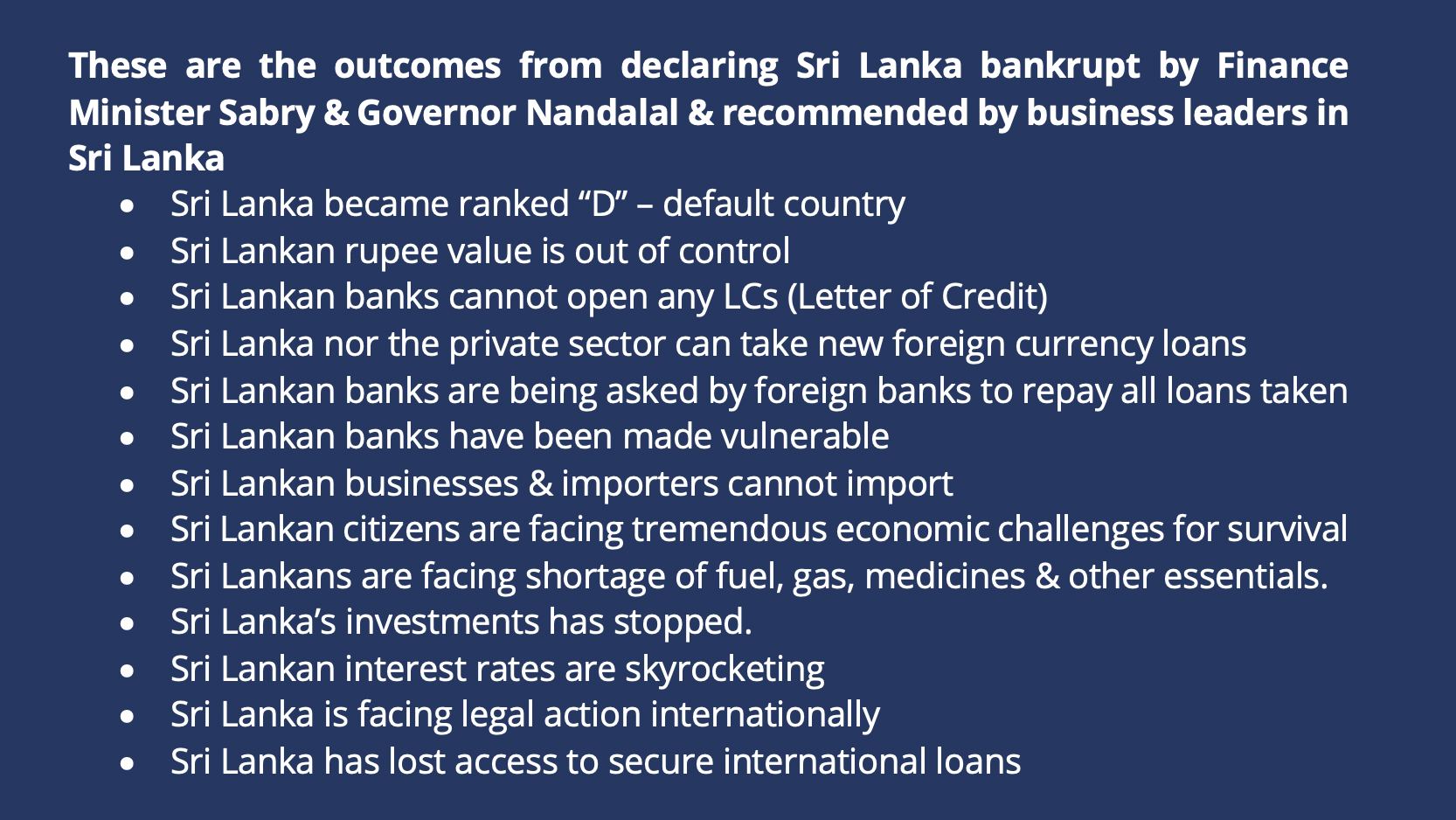
Sri Lanka was always sitting on a time bomb. Our expenses were higher than our income/revenues, our imports were higher than our exports, we were living a superficial life on loans, taking more loans to settle loans and even loans to continue our lifestyle – it was only a matter of time that the bomb would explode. Confounding matters were several internal and global calamities – covid, global fuel crisis from Ukraine war, loss of revenues that Sri Lanka had been reliant on. The situation was well known to experts planning policy, advising governments and the top echelons of society. Now that we know the consequences of defaulting and free floating the rupee as well as the international legal cases against Sri Lanka – we have every right to question every “expert” who prescribed these as their expert recommendation for Sri Lanka and citizens have every right to hold them equally accountable for the current plight. The situation has been made worse without dealing with the economic crisis but by creating a political crisis leading to double jeopardy for the nation.
These are the outcomes from declaring Sri Lanka bankrupt by Finance Minister Sabry & Governor Nandalal & recommended by business leaders in Sri Lanka
- Sri Lanka became ranked “D” – default country
- Sri Lankan rupee value is out of control
- Sri Lankan banks cannot open any LCs (Letter of Credit)
- Sri Lanka nor the private sector can take new foreign currency loans
- Sri Lankan banks are being asked by foreign banks to repay all loans taken
- Sri Lankan banks have been made vulnerable
- Sri Lankan businesses & importers cannot import
- Sri Lankan citizens are facing tremendous economic challenges for survival
- Sri Lankans are facing shortage of fuel, gas, medicines & other essentials.
- Sri Lanka’s investments has stopped.
- Sri Lankan interest rates are skyrocketing
- Sri Lanka is facing legal action internationally
- Sri Lanka has lost access to secure international loans
The present Governor – has been with not only Sri Lanka’s Central Bank but was a Director of the IMF as well & had been on every top expert Committee in the CBSL. He too should have known the adverse impact of defaulting debt repayment.

As for Finance Minister Sabry – his glorified speech in Parliament has only become
a pusswedilla following the outcome of defaulting.
Then there are the business and think tanks experts that prescribed to default repayment:
Note how all are justifying defaulting payment of loans claiming to save the money to purchase money for essentials. This is a layman’s answer and not one expected of experts knowing the above repercussions Sri Lanka has had to face as a result of non-payment.

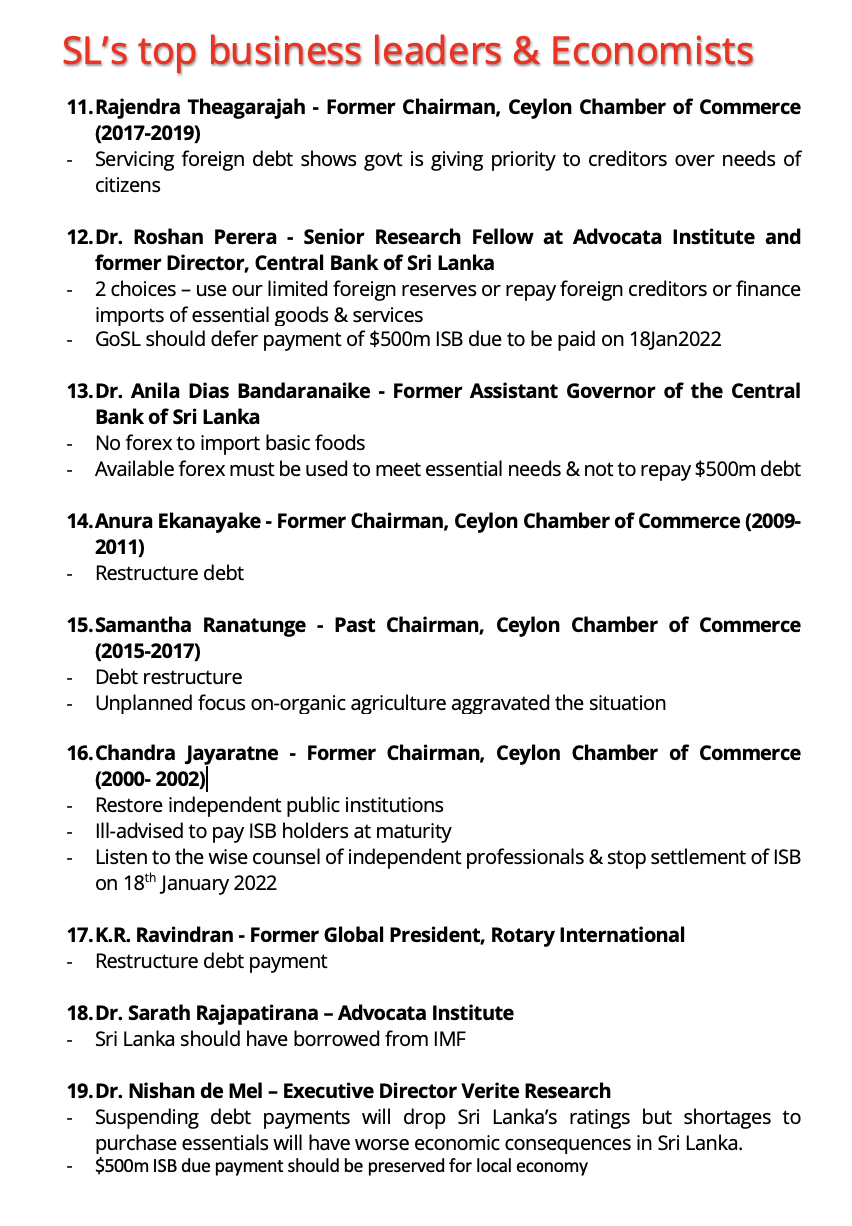
What was the issue regarding honoring repayment of loans taken?
State of International Sovereign Bonds
- From 2009 to 2014 – USD5000millon worth international sovereign bonds were issued by the Central Bank of SL
$5000m ISBs taken from 2009-2014 enabled Sri Lanka’s GDP growth from $42.1b in 2009 to $79.4b in 2014 (a growth of $37.3b in 5 years)
- From 2015 to 2019 – 5billon worth international sovereign bonds had been issued by the Central Bank of SL agreeing to pay at high a interest rate of 7.85%
$12.5b ISBs taken from 2015-2019 saw a marginal GDP growth from $79.4b to $84b
Sri Lanka’s foreign exchange reserves from 2015-2019 was only $8.208m
- From 2020 to 2022 no sovereign bonds were issued.
At the end of Rajapakse term in early January 2015 Sri Lanka’s foreign reserves were $8.2b & ISB outstanding were $5b & net reserves were a positive $3.2b
By the end of 2019 Indrajit Coomaraswamy’s term as Governor, reserves were $7.6b & ISB outstanding were $15b & net reserves were a negative $7.4b
From early January 2022, there were regular calls for non-payment of foreign debt. This call emerged when the CBSL was to pay $500m on 18th January 2022 for $500m ISB taken on 18 July 2016 at the rate of 5.75% interest.
In 2022 Sri Lanka also had to pay total $7b loan repayment.
Sri Lanka paid $1166m in March2022 (in addition to the $500m paid in Jan2022)
Sri Lanka was due to pay $78m in April2022 – why couldn’t Sabry & Nandalal do so?
More importantly, why couldn’t they have renegotiated its payment.
It is absolutely shocking that these 2 put Sri Lanka on bankruptcy status simply for $78m non-payment while the business experts of Sri Lanka also nodded approval!
Had Sri Lanka taken the advice of these experts, Sri Lanka would have been in a pickle in January2022 itself.
Given that the economic crisis became a political crisis, we now have to wonder whether the economic crisis was part of the political crisis to which many were in the know.
Leading the political crisis as usual was the JVP openly calling for street riots by People.
Sumanthiran & EranW led the onslaught against repayment of debt loans (Jan2022) Sumanthiran was the Chairman of the Parliamentary Committee on Public Finance.
https://www.ft.lk/front-page/All-borrowings-used-to-repay-debt–Eran/44-680288 – all these are well known ‘economists’ and bankers — so when people like Eran Wickremaratne too promotes it — we are baffled as to whether these are ‘experts’ in their realms of expertise
Even SJB’s Harsha de Silva was promoting defaulting while not providing clear solutions or answers
In the context of what Sri Lanka is facing as a result of defaulting, we have to question these calls for non-payment!
Was part of the crisis to leave no option but to go to IMF?
https://island.lk/gammanpila-favours-deal-with-imf-says-most-ministers-like-minded/ Udaya Gammanpila in Feb2022 declared “I have expressed my view that we should go to the IMF. Now most of the cabinet ministers are for an IMF deal,”
Harsha de Silva too was a heavy campaigner of going to IMF.
A pre-requisite to IMF program was to agree to a rate hike and a float of currency.
It was alleged that the CBSL was printing money at a rate prior to April 2022 but the amount of money currently being printed exceeds all previous amounts.
W A Wijewardena former Deputy Governor CBSL was a vociferous advocate of free floating of the rupee (a key IMF feature)
Was this why Sabry-Nandalal declared Sri Lanka bankrupt embarrassing Sri Lanka & making Sri Lanka vulnerable?
Was the plan to make the nation & people suffer as it left no choice for Sri Lanka?
Was this choice already kept lined up with their “wish list” in exchange for aid?
Was this why faces were quickly changed?
Whose decision was it to float the rupee? A collective decision by CBSL top management
Whose decision was it to default on repayment? Sabry-Nandalal & a coterie of 19 top businessmen/women
Thankfully, Sri Lanka CBSL not only paid $500m in Jan2022 but also $1066m in Mar2022. So why couldn’t CBSL pay $78m in April22?
If Sri Lanka had not honored repayment as advised by top business leaders, economists, politicians and even former Central Bank heads – Sri Lanka would have faced being sued by bondholders much earlier than the case currently filed against Sri Lanka in Jun2022 by Hamilton Reserve Bank Ltd for full payment of default on $1billion at 5.87% interest due on 25 July 2022.
https://ca.news.yahoo.com/sri-lanka-sued-bondholder-us-094716058.html
It is also baffling why Sabry-Nandalal defaulted on the $78m repayment due on 12 April 2022 when China had assured to support with $1b in cash & $1.5b in trade finance over and above the support extended by India.
All these “experts” have landed Sri Lanka in this crisis status. People should evaluate their actions against what the People are having to face.
Shenali D Waduge
Sri Lanka blocks Yuan Wang-Spy ship’s visit easing Indian tensions
In a new twist soothing the tensions between China and India Indian ocean maritime security, Sri Lanka has asked China to indefinitely delay a visit by a ship with long-range scanning capabilities that can be used to map defense installations and help the Chinese military’s strategic planning.
Following a strong protest by India, Sri Lanka has blocked the proposed visit by a Chinese “spy vessel’’ to the Hambantota port in southern Sri Lanka.
In an official communication, the Lankan foreign ministry asked the Chinese embassy in Colombo to defer the arrival of the ship “until further consultations, official sources said.
The Yuan Wang 5 is en route from the Chinese port of Jiangyin and due in the Chinese-run Sri Lankan port of Hambantota on Thursday, according to analytics website MarineTraffic.
It is described as a research and survey vessel, but according to CNN-News18 is a dual-use spy ship, employed for space and satellite tracking and with specific usage in intercontinental ballistic missile launches.
India lodged a verbal protest with Sri Lanka President Ranil Wimasinghe , while a spokesman for New Delhi’s Foreign Ministry said the government “carefully monitors any developments having a bearing on India’s security and economic interests, and takes all necessary measures to safeguard them.”
President Wickremesinghe assured political party leaders on Friday that the controversial visit will not go ahead as planned.
Earlier this week, Colombo appeared to brush aside Indian concerns, saying the vessel was coming only to refuel and replenish supplies and would not undertake any work in Sri Lankan waters.
Sri Lanka gave the green light for the Yuan Wang 5 to call at the Chinese-built and controlled Hambantota Port in the south, expecting the ship to stay from Aug. 11 to 17.
India, however, made it clear that it is unhappy about the prospect of the vessel and its advanced surveillance systems docking in its backyard.
Prior to Saturday’s reports, Col. Nalin Herath, a spokesman for Sri Lanka’s Ministry of Defense, had told Nikkei that local authorities approved China’s request for permission to dock based on the “standard procedure.”
He stressed that this was “not the first Chinese naval ship to come to Sri Lanka,” and that vessels from a range of countries including India and the U.S. have also called in the past.
The colonel said China declared the visit would be for replenishing fuel and other supplies.
But some local and Indian experts found that curious, considering Sri Lanka is in the middle of a severe fuel crisis due to a lack of foreign currency. Within the country, fuel for vehicles is only available on a weekly quota basis.
Expiring CCVIs of Korean job seekers to be extended
A discussion was held between Minister of Foreign Employment Manusha Nanayakkara and the Country Director of the Human Resources Department of Korea, Lee on the Certificate of Confirmation Visa Issue (CCVI) of Korean job seekers at the Foreign Employment Bureau.
Accordingly, Minister Nanayakkara has drawn the attention of the Country Director to extend the expiring CCVIs, and in a positive response, consensus has been reached to extend the period by six months.
The delay in obtaining the Korean visa due to the delay in obtaining the Police clearance reports has also been discussed with the Country Director of the Korean Human Resources Department.
The subject Minister also drew attention to the lack of dispatches of Korean career opportunities lately and Lee responded saying that the priority given to that sector as per the request of the Korean Shipbuilders’ Association was the reason behind the decline.
MIAP
China assures not to harm Sri Lanka’s interests in keeping its friendship
Chinese State Councilor and Foreign Minister Wang Yi met with Sri Lankan Minister of Foreign Affairs Ali Sabry in Cambodia with both sides speaking highly of their long-lasting friendship.
During the talks with Sabry on the sidelines of the meetings of foreign ministers on East Asia cooperation, Wang said China and Sri Lanka have enjoyed long-lasting and traditional friendship.
The Chinese government and people have provided multiple batches of emergency humanitarian assistance to Sri Lanka and will continue to extend assistance through bilateral and multilateral channels, he said.
Wang said he believes that the new government of Sri Lanka will unite and lead its people in getting through the difficulties and push the country back to the right track of development.
China firmly supports Sri Lanka in safeguarding national sovereignty and independence, resolving its debt problem through consultation, maintaining policy continuity, safeguarding social stability and realizing economic recovery, he added.
Wang said history has proven and will continue to prove that China will never do anything to harm Sri Lanka’s interests and will always be its sincere and reliable friend.
For his part, Sabry thanked the Chinese government and people for their timely assistance to Sri Lanka in times of difficulty.
With special and long-lasting bilateral relationship, Sri Lanka and China have always trusted and supported each other, Sabry said.
Sri Lanka cherishes its friendship with China, firmly adheres to the one-China principle and opposes any action that interferes in China’s internal affairs and stokes tensions, he said.
Refuting the so-called Chinese “debt trap” claim, Sabry stressed that China only accounts for 10 percent of Sri Lanka’s external debt, saying Sri Lanka would not have achieved development at all without China’s help.
Sri Lanka will protect the legitimate rights and interests of Chinese investors, he added.
President issues extraordinary gazette adding amendments to Emergency Regulations
President Ranil Wickremesinghe has issued an extraordinary gazette declaring certain amendments to be placed in the Emergency Regulations issued on July 18.
Accordingly, the following amendments have been made to the clauses relating to search and arrest and those to penalisation on conviction in a High Court.

MIAP
WFP says rising prices reduce access to food for millions in Sri Lanka:
Sri Lanka’s worst economic crisis since independence is spinning off a “serious food crisis,” said World Food Programme Representative and Country Director Abdur Rahim Siddiqui, while describing a toxic mix of spiking prices, shrinking crop yields, the fallout of the war in Ukraine and a lack of state funds to pay for key supplies.
“The economy has collapsed and the country has run out of the money needed to import essentials like fuel, food and fertiliser,” he said, and urged more donor support to WFP and other humanitarian responders.
A recent assessment by WFP and the UN Food and Agriculture Organization (FAO) showed that 6.3 million people – nearly 30 percent of the population – are food-insecure. It comes as WFP warns of an unprecedented global food crisis.
Sri Lanka is grappling with a record 90 percent food inflation, making even staples such as rice unaffordable for millions of families. The average monthly cost of a nutritious diet has soared 156 percent since 2018.
The WFP highlighted that multiple factors are shaping Sri Lanka’s food crisis. In its bid to make farming more environmentally sustainable, the government last year banned imported chemical fertilisers.
However, the move sharply reduced agricultural output – and while import rules have since been eased, the effects remain.After two consecutive harvest failures, a third would be “catastrophic,” said Siddiqui.
Sri Lanka is also feeling the aftershocks of the war in Ukraine. Along with disrupting key grain exports and driving up global food and fuel prices, the conflict has battered two of its top tourist markets – Russia and Ukraine itself – reducing the availability of hard currency and, in turn, Sri Lanka’s ability to import, with far-reaching effects.
“Around 200,000 fishermen are out of their livelihoods because this country doesn’t have fuel following import restrictions. We need to provide support to the smallholder farmers.”
“International organisations like WFP have a duty to step in to provide emergency food assistance to the most vulnerable cross-section of the population,” added the WFP official.
WFP kicked off its emergency response operation in mid-June, distributing food vouchers to pregnant women in some of the underserved sections of the capital.
The programme, via its emergency response aims to scale up and reach 3.4 million people with food and nutrition assistance.

